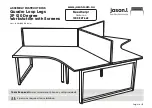
12
CAUTION!
RISK OF INJURY TO PERSONS
While you are preparing to use the treadmill, do not stand on the belt. Place
your feet on the side rails before starting the treadmill. Start walking on the
belt only after the belt has begun to move. Never start the treadmill at a fast
running speed and attempt to jump on! In case of an emergency, place both
hands on the side arm rests to hold yourself up and place your feet onto the
side rails.
USING THE SAFETY KEY
Your treadmill will not start unless the emergency stop button
is reset. Attach the clip end securely to your clothing. This safety
key is designed to cut the power to the treadmill if you should
fall. Check the operation of the safety key every 2 weeks.
WARNING!
Never use the treadmill without securing the safety key
clip to your clothing. Pull on the safety key clip first to
make sure it will not come off your clothing.
Only engage reverse belt direction in a supervised
environment. The maximum default belt speed is 2 mph and
should only be changed by an authorized technician.
PROPER USAGE
Position your feet on the belt, bend your
arms slightly and grasp the heart rate
sensors (as shown). While running, your feet
should be located in the center of the belt
so that your hands can swing naturally and
without contacting the front handlebars.
Your treadmill is capable of reaching high speeds. Always start off using
a slower speed and adjust the speed in small increments to reach a
higher speed level. Never leave the treadmill unattended while it is
running. When not in use turn the on/off switch to off and unplug the
power cord. Make sure to follow the MAINTENANCE schedule in this
guide to maintain optimal performance and prevent premature electronic
failure. Keep your body and head facing forward. Do not attempt to
turn around or look backwards while the treadmill is running. Stop your
workout immediately if you feel pain, faint, dizzy or are short of breath.
USING THE HEART RATE FUNCTION
The heart rate function on this product is not a medical device. While heart rate grips
can provide a relative estimation of your actual heart rate, they should not be relied
on when accurate readings are necessary. Some people, including those in a cardiac
rehab program, may benefit from using an alternate heart rate monitoring system
like a chest or wrist strap. Various factors, including movement of the user, may affect
the accuracy of your heart rate reading. The heart rate reading is intended only as an
exercise aid in determining heart rate trends in general. Please consult your physician.
PULSE GRIPS
Place the palm of your hands directly on the grip pulse handlebars. Both hands must grip
the bars for your heart rate to register. It takes 5 consecutive heart beats (15-20 seconds)
for your heart rate to register. When gripping the pulse handlebars, do not grip tightly.
Holding the grips tightly may elevate your blood pressure. Keep a loose, cupping hold.
You may experience an erratic readout if consistently holding the grip pulse handlebars.
Make sure to clean the pulse sensors to ensure proper contact can be maintained.
WIRELESS HEART RATE RECEIVER
When used in conjunction with a
wireless chest transmitter, your heart rate
can be transmitted wirelessly to the unit and displayed on the console.
Prior to wearing the wireless chest transmitter on your chest, moisten the two rubber
electrodes with water. Center the chest strap just below the breast or pectoral muscles,
directly over your sternum, with the logo facing out. NOTE: The chest strap must be tight and
properly placed to receive an accurate and consistent readout. If the chest strap is too loose,
or positioned improperly, you may receive an erratic or inconsistent heart rate readout.
WARNING!
Heart rate monitoring systems may be inaccurate. Over exercising may result in
serious injury or death. If you feel faint, stop exercising immediately.
Backside of chest strap
Apply moisture here
ENGLISH













































